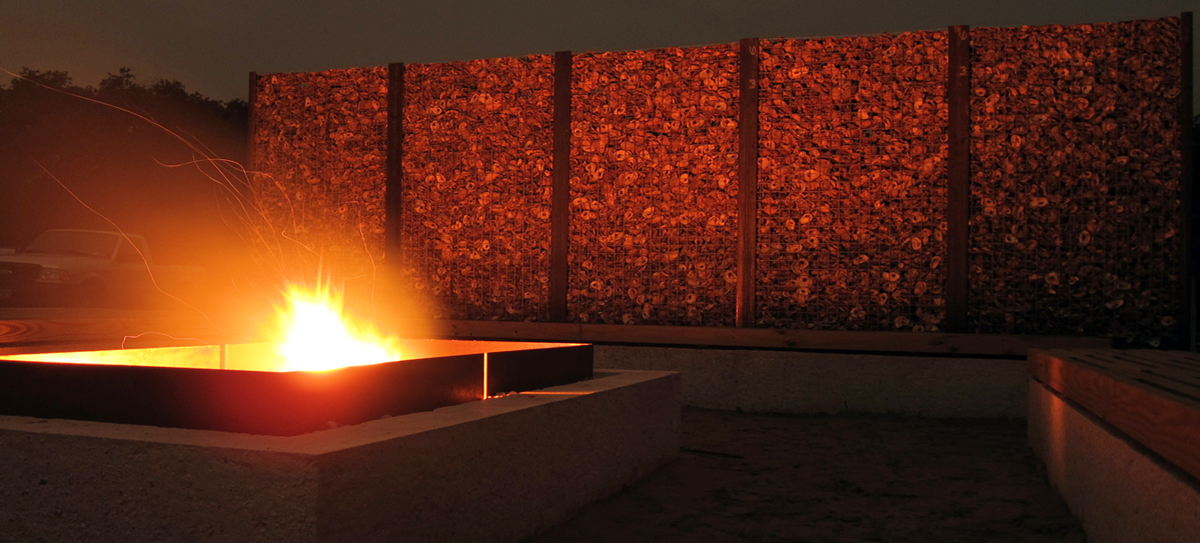
GATHER
Fall 2014 | Goose Island State Park | Lamar Peninsula Texas
Project Team: Rachel Duggan, Katherine Eastman, Jamie Epley, Huiming Zuo (Zoe), Thomas Johnston, Kuan Liu, Celine Pinto, Ruihua Cai (Mark), Luke Stevenson, Teng Li (James)
Texas Parks and Wildlife Department has an active program of environmental education for its visitors. These activities are as varied as bird, reptile and sea life identification, recognizing edible from poisonous plants, stargazing, as well as groups of high school students wading out into Texas bays to help reestablish oyster reefs. These activities give visitors a deeper appreciation for their environment. Goose Island State Park has similar programs. The Park, eight miles north of Fulton Texas on the Gulf coast, sits on the eastern edge of Aransas Bay where Copano and St Charles Bay converge. The Park known for its winter bird watching is thick with coastal live oak. It’s home to the thousand-year-old “Big Tree,” one of the nation’s largest live oaks. Goose Island sits adjacent to the Aransas National Wildlife Refuge, winter home to the Whooping Crane, a highly endangered species (down to about forty birds a few decades ago, now making a slow comeback with about three hundred Cranes). Whoopers are frequent guests at Goose Island.
Park officials invited architecture students to develop a designbuild project for Goose Island’s Youth Area. Boy and Girl Scout troops camp here often. This is also the place where nature tours begin. These include interpretive talks and demonstrations by Park Rangers. Surrounded by dense live oak and thick underbrush the Youth Area clearing forms an outdoor room of about half an acre. Students were asked to design and build a fire circle for twenty visitors, an area where the Park’s nature interpreter orients visitors before nature walks and a place to set up telescopes for stargazing events. They were also to lay out a master plan for the Youth Area that included a future outdoor dining pavilion for campers and additional camp sites.
Before beginning students studied the area’s ecological system with hands-on trips to nearby bays and barrier islands. This included a visit to Corpus Christi and the Bay Education Center in Rockport run by Mission Aransas National Estuarine Research Reserve. By boat they also visited El Copano, an abandoned seaport town on Copano Bay, settled by the Spanish to serve early Missions inland. Later other European immigrants settled the town using shellcrete to build their community. Shellcrete made from oyster shells was locally available in abundance. Shells burned over a fire for several days until they were reduced to calcium oxide (quicklime). When mixed with whole oyster shells, sand and water this produced its own kind of concrete, well suited for the wet coastal climate. Shellcrete became an integral component to the student’s design.
The final scheme begins with a steel lined firebox surrounded on three sides by seating and an eight-foot wide stargazing deck on the fourth. There’s also a seven-foot high oyster shell gabion wall that gives the fire circle a room-like scale. This wall also shields users from nearby parking. To add to the sense of enclosure the work was nestled close to the northmost tree line. Shellcrete (modernized by adding Portland cement to the traditional mix) was used for bench bases that face the fire circle. Bases toward the outside are Portland cement concrete. Wood was used for seating areas and deck surfaces. This pattern uses 1 x oak spacers between the vertically turned 2 x 4’s. The use of oak, shellcrete and oyster shells is meant as talking points for the Park’s nature interpreters when describing the ecological and cultural characteristics of the area.
The American Society of Landscape Architects recognized this project with a national “Student Collaboration” award in 2015
The University of Texas at Austin School of Architecture recognized this project with a Design Excellence Award for 2014-2015
View Construction Phase Video →
.